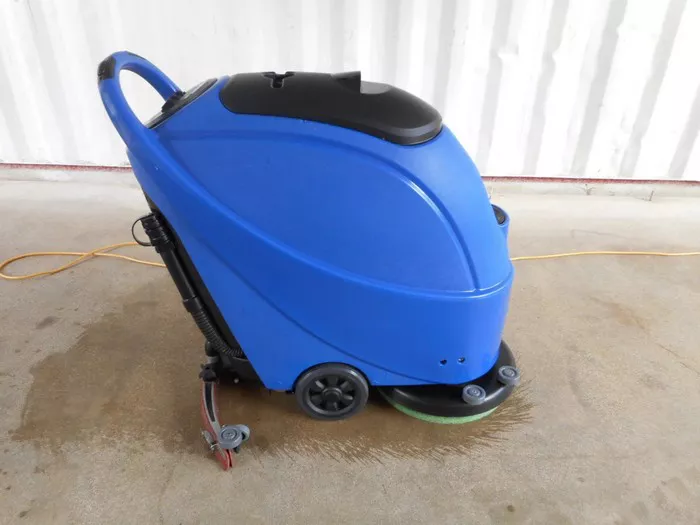Floor scrubbers are indispensable tools in maintaining cleanliness and hygiene in various settings, from industrial warehouses to commercial spaces and even residential buildings. These machines efficiently remove dirt, grime, and stains from floors, leaving them sparkling clean and safe to walk on. However, operating a floor scrubber requires proper training and understanding of its functionalities to ensure optimal performance and safety. In this guide, we’ll delve into the intricacies of operating a floor scrubber effectively.
Understanding Your Floor Scrubber
Before diving into operating the floor scrubber, it’s crucial to familiarize yourself with its components and functionalities. Typically, a floor scrubber consists of:
1. Main Body: This houses the motor, water tank, and other essential components.
2. Brush or Pad: Attached to the underside of the machine, these components agitate and scrub the floor surface.
3. Squeegee Assembly: Located at the rear of the machine, it collects dirty water and prevents it from being spread across the floor.
4. Controls: These include switches, buttons, and levers for controlling the movement and operation of the machine.
Operating Procedures
Preparation:
1. Inspect the area to be cleaned for any obstacles or hazards.
2. Clear the floor of any debris or large objects.
3. Fill the water tank with clean water and add the appropriate cleaning solution as per manufacturer’s recommendations.
Start-Up:
1. Turn on the main power switch and any other necessary switches for brush rotation and water flow.
2. Adjust the brush pressure or pad pressure according to the type of floor surface.
3. Engage the drive system and slowly move the floor scrubber forward.
Scrubbing:
1. Move the floor scrubber in a systematic pattern, such as overlapping passes, to ensure thorough cleaning.
2. Pay attention to areas with stubborn stains or heavy soiling, applying extra pressure if needed.
3. Refrain from making abrupt turns to prevent damage to the machine and ensure uniform cleaning.
Water and Solution Management:
1. Monitor the water and solution levels throughout the cleaning process.
2. Refill the water tank or replenish the cleaning solution as necessary to maintain optimal cleaning performance.
Drying:
1. Once the cleaning is complete, engage the squeegee assembly to collect the dirty water.
2. Ensure the floor is left dry and free of any excess moisture to prevent slips and falls.
Safety Measures
1. Always wear appropriate personal protective equipment, including gloves and safety goggles, when operating a floor scrubber.
2. Follow all manufacturer’s guidelines and safety instructions provided in the user manual.
3. Be mindful of electrical cords and other potential trip hazards while operating the machine.
4. If operating a ride-on floor scrubber, be cautious of other personnel or obstacles in the area to avoid collisions.
Maintenance Tips
1. Regularly clean and inspect the brushes or pads for wear and tear, replacing them when necessary.
2. Clean the squeegee assembly and ensure it is free of debris to maintain optimal suction and water recovery.
3. Check the battery (if applicable) and charger regularly to ensure they are functioning correctly.
4. Keep the machine clean and well-maintained to prolong its lifespan and ensure consistent performance.
Conclusion
Operating a floor scrubber efficiently requires a combination of proper training, understanding of the machine’s functionalities, and adherence to safety measures. By following the guidelines outlined in this comprehensive guide, you can achieve optimal cleaning results while ensuring the safety of yourself and others in the vicinity.
FAQs
Q1: How often should I clean and maintain my floor scrubber?
A1: It’s essential to clean and maintain your floor scrubber regularly to ensure optimal performance and longevity. Depending on the frequency of use and the type of environment it operates in, you should perform routine maintenance tasks such as cleaning the brushes, inspecting the squeegee assembly, and checking the battery (if applicable) at least once a week.
Q2: Can I use any cleaning solution in my floor scrubber?
A2: While it’s tempting to use any cleaning solution available, it’s crucial to use only the cleaning solutions recommended by the manufacturer for your specific floor scrubber model. Using incompatible solutions can damage the machine and compromise cleaning performance. Always refer to the user manual or contact the manufacturer for guidance on suitable cleaning solutions.
Q3: What should I do if my floor scrubber encounters a problem during operation?
A3: If your floor scrubber encounters a problem during operation, such as loss of suction, brush malfunction, or electrical issues, it’s essential to stop the machine immediately and troubleshoot the problem. Refer to the user manual for troubleshooting tips, and if you’re unable to resolve the issue, contact the manufacturer or a qualified technician for assistance. Avoid attempting to repair the machine yourself, as this can lead to further damage or safety hazards.

